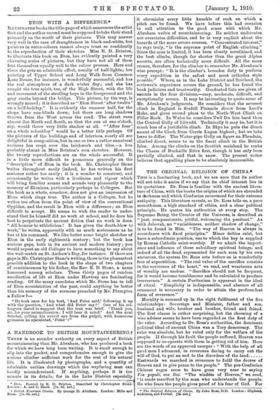ETON WITH A DIFFERENCE.* ILLUSTRATED books the title-page of which
announces the artist first and the author second must be supposed to take their stand
primarily on the worth of their pictures. This may answer very well in the case of draughtsmen in black-and-white, but painters in water-colours cannot always trust so confidently to the reproduction of their sketches. Miss E. D. Brinton, to illustrate this book on Eton, has evidently painted a very .:harming series of pictures, but they have not all of them lent themselves equally well to the colour process. Here and there she gets an admirable effect, usually of half-lights; her painting of Upper School and Long Walk from Common Ione House, for instance, is wonderfully successful, and has the real atmosphere of a dark winter day; and she has caught the true spirit, too, of the High Street, with the life and movement of the strolling boys in the foreground and the grey castle, beyond the bridge. This picture, by the way, is wrongly named ; it is described as " Eton Street after twelve' on a half-holiday." It is evidently the summer half, for the shops have sun-blinds down; but there are long shadows thrown from the 'West across the road. The street runs almost due North and South, so that the sun at one o'clock, say, would throw very little shadow at all. "'After four' on a whole schoolday " would be a better title perhaps. Of the pictures of the buildings and of interiors, nearly all are delightful in composition, but in one or two a rather unnatural rosiness has crept over the brickwork and tiles,—a hue probably absent in Miss Brinton's own sketches. However, the twenty reproductions are on the whole successful It is a little more difficult to pronounce generally on the "description" of Eton in the book. Mr. Christopher Stone writes throughout easily (indeed, he has written his first sentence rather too easily; it is a wonder to construe), and occasionally he writes with a liveliness and vigour which will bring familiar scenes and sounds very pleasantly to the memory of Etonians, particularly perhaps to Collegers. But the book as a whole, somehow, does not give an impression of Eton which rings true. The author is a Colleger, but be writes too often from the point of view of the conventional Oppidan, and the result is Eton with a difference; an Eton difficult to accept. He seems to wish the reader to under- stand that he himself did no work at school, and he does his best to perpetuate the ancient fiction that no work is done. " All honour to athleticism ! It has given the death-blow to work," he writes, apparently with as much seriousness as he has at his command. We like better some bright sketches of Eton in the early eighteenth century; but the book has curious gaps, both in its ancient and modern history ; you would expect an old Colleger to have something to say about the wall-match on St. Andrew's Day, for instance. If there are gaps in Mr. Christopher Stone's writing, there is the pleasantest possible addition to the book in the shape of two chapters of reminiscences by his father, the Rev. E. D. Stone, a name honoured among scholars. These thirty pages of random recollection of life at Eton under Hawtrey are fascinating
reading. Of the many anecdotes which Mr. Stone has to tell of Eton eccentricities of the past, could anything be better than his memory of the sermons preached by Mr. Plumptre a Fellow 10— "He took once for his text, 'And Peter said,' following it up with the question, And what did Peter say?' One of his col- leagues dared to suggest that the text was brief. Thank you, sir, for your animadversion: I will bear it mind.' And the next Sunday, rolling his swivel eye from the pulpit, with humorous grimness he ejaculated, 'Peter'!"














































 Previous page
Previous page